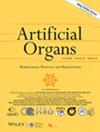Experimental Investigation of the Applicability of the Stress-Based and Strain-Based Hemolysis Models for Short-Term Stress Peaks Typical for Rotary Blood Pumps
Abstract
Background
Although flow simulations have become more accurate, hemolysis prediction models still show large deviations from measured values in blood-carrying devices. To develop and validate more accurate models, specific hemolysis experiments are needed to determine the influence of parameters on hemolysis, such as stress type and exposure time typical for rotary blood pumps (RBPs).
Methods
In order to investigate the applicability of the hemolysis models to the flow in RBPs, this study performed experiments with human whole blood in three differently shaped flow channels that generate short-term stress peaks. CFD simulations were performed and the applicability of the stress-based and strain-based hemolysis models was investigated by comparing them with the experimental results.
Results
Low and statistically non-significant hemolysis was measured for all geometries and 1200 load repetitions. The CFD simulations determined scalar shear stresses up to 1500 Pa with exposure times in the millisecond range. The stress-based hemolysis model overestimated hemolysis by several orders of magnitude and predicted significant differences between the three flow channels. The strain-based hemolysis model predicted low and approximately equal hemolysis, in agreement with the experimental results.
Conclusion
The results suggest that the stress-based hemolysis model is not appropriate for the applied short-term stress peaks. The strain-based model, which considers the deformation of the RBCs over time, appears to be more appropriate for this type of flow. This implies a similar relationship for RBPs, where these short-term stress peaks are typical.


 求助内容:
求助内容: 应助结果提醒方式:
应助结果提醒方式:


